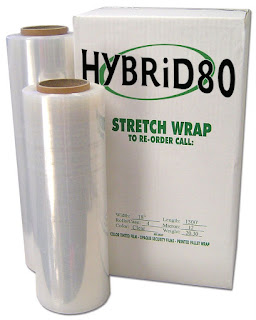The Benefits of HYBRiD Plus Converted Stretch Film
The Benefits of HYBRiD Plus Converted Stretch Film
HYBRiD Plus Converted
film is stretched close to its ultimate break point prior to being wound onto
rolls for final use. This means the film
doesn't require as much stretching energy as a standard stretch film to achieve
the same wrapping force. This is a key reason why pre-stretched films are
popular for hand wrap. In fact, with pre-stretched wrap, hand applications can
create the same load stability as machine applications. The benefits of this
are obvious.
We make HYBRiD Plus converted film by stretching it at high
speed between pre-stretching rollers. Since the surface of the roller rotates
faster than the primary roller, the film gets pulled between them and
stretches. The resulting rolls are generally light and easy to handle, reducing
operator fatigue. Since there’s very
little torque involved, users also benefit by being able to use a walk-forward
wrapping technique, which can help prevent slip and fall incidents.
In terms of material costs, HYBRiD Plus films are much
thinner than traditional stretch films. Ultimately, this produces less environmental
waste since the operator uses less material during application.
There are many benefits to using HYBRiD Plus Converted
stretch film. Basically, users get the
same (or better) load stability with less product, less physical energy, and
greater control.
HYBRiD Plus converted film consumption can be less to one
half that of traditional stretch film. This creates a cost savings of anywhere
from 25% - 50%.
No Edge Damage (no wasted rolls): HYBRiD Plus converted film has rolled edges
and has air blown into the roll to support the middle of the roll from
telescoping down. These two processes
together make it almost impossible to damage the roll edge when dropping it. Traditional stretch film rolls often are
thrown away because the user drops them and damages the edge.
Easier to Apply: Lower
torque requirements allow users to walk forward instead of backward during application
– making for safer and easier control. Also, little or no stretching is required,
so it much easier to wrap with less physical strength. The roll is lighter (about
50% less than traditional film) and easier to manage. It’s about half the thickness and double the
strength.
Film Memory: Since
the film is applied to the load with little force, it will naturally tighten
after application. This unique film memory and its tendency to tighten after
application is the single most important reason for pre-stretching film.
Stretch Consistency:
Traditional stretch film does not provide uniform stretch, so its
performance is unpredictable; this leads to intermittent load failures. The performance of pre-stretched film is much
more controllable.
Other Benefits
• No width reduction during tensioning reduces the number of
film wraps required.
• Excellent film cling ensures that film tails will stay in
place.
• Good film clarity allows easier inspection of packaged
products.
• Superior load retention provides better load stability.
• It stabilizes misshapen and protruding loads.
• It performs well in extreme cold.
• It facilitates compliance with Packaging Waste regulations
- using less means less to dispose of.
Most hand-held stretch films need to be stretched at least
100 to 150 percent to make the film stiff enough to effectively hold a shifting
load. In reality, operators rarely stretch film more than 50 percent during the
wrap process.
A nationwide evaluation of hand wrapping in real-life situations,
found that the average person stretches hand wrap less than 15%.
Buy the film here: www.quickpakinc.com




Comments
Post a Comment